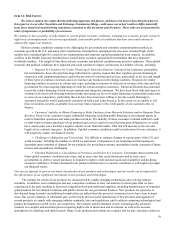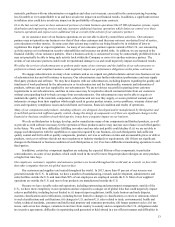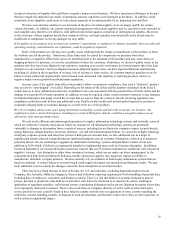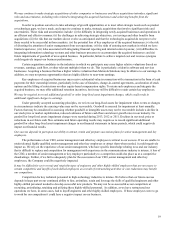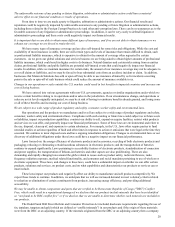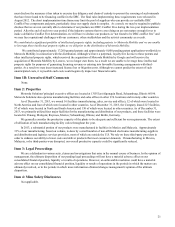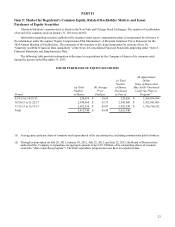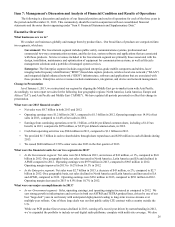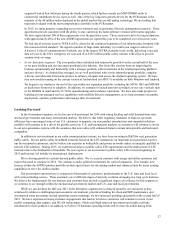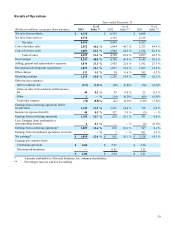Motorola 2013 Annual Report Download - page 21
Download and view the complete annual report
Please find page 21 of the 2013 Motorola annual report below. You can navigate through the pages in the report by either clicking on the pages listed below, or by using the keyword search tool below to find specific information within the annual report.19
We may continue to make strategic acquisitions of other companies or businesses and these acquisitions introduce significant
risks and uncertainties, including risks related to integrating the acquired businesses and achieving benefits from the
acquisitions.
In order to position ourselves to take advantage of growth opportunities or to meet other strategic needs such as product
or technology gaps, we have made, and expect to continue to make, strategic acquisitions that involve significant risks and
uncertainties. These risks and uncertainties include: (i) the difficulty in integrating newly-acquired businesses and operations in
an efficient and effective manner; (ii) the challenges in achieving strategic objectives, cost savings and other benefits from
acquisitions; (iii) the risk that our markets do not evolve as anticipated and that the technologies acquired do not prove to be
those needed to be successful in those markets; (iv) the potential loss of key employees of the acquired businesses; (v) the risk
of diverting the attention of senior management from our operations; (vi) the risks of entering new markets in which we have
limited experience; (vii) risks associated with integrating financial reporting and internal control systems; (viii) difficulties in
integrating information technology systems and other business processes to accommodate the acquired businesses; and (ix)
future impairments of goodwill of an acquired business. In particular, failure to achieve targeted cost and revenue synergies
could negatively impact our business performance.
Certain acquisition candidates in the industries in which we participate may carry higher relative valuations (based on
revenues, earnings, cash flow, or other relevant multiples) than we do. This is particularly evident in software and services
businesses. Acquiring a business that has a higher relative valuation than Motorola Solutions may be dilutive to our earnings. In
addition, we may not pursue opportunities that are highly dilutive to near-term earnings.
Key employees of acquired businesses may receive substantial value in connection with a transaction in the form of cash
payments for their ownership interest, particularly in the case of founders, change-in-control agreements, acceleration of stock
options and the lifting of restrictions on other equity-based compensation rights. To retain such employees and integrate the
acquired business, we may offer additional retention incentives, but it may still be difficult to retain certain key employees.
We may be required to record additional goodwill or other long-lived asset impairment charges, which could result in
additional significant charges to earnings.
Under generally accepted accounting principles, we review our long-lived assets for impairment when events or changes
in circumstances indicate the carrying value may not be recoverable. Goodwill is assessed for impairment at least annually.
Factors that may be considered in assessing whether goodwill or intangible assets may not be recoverable include a decline in
our stock price or market capitalization, reduced estimates of future cash flows and slower growth rates in our industry. No
goodwill or long-lived assets impairment charges were recorded during 2013, 2012 or 2011. Declines in our stock price or
reductions in our future cash flow estimates and future operating results may require us to record significant additional
goodwill or other long-lived asset impairment charges in our financial statements in future periods, which could negatively
impact our financial results.
Our success depends in part upon our ability to attract, retain and prepare succession plans for senior management and key
employees.
The performance of our CEO, senior management and other key employees is critical to our success. If we are unable to
retain talented, highly qualified senior management and other key employees or attract them when needed, it could negatively
impact us. We rely on the experience of our senior management, who have specific knowledge relating to us and our industry
that is difficult to replace and competition for management with experience in the communications industry is intense. A loss of
the CEO, a member of senior management or key employee particularly to a competitor could also place us at a competitive
disadvantage. Further, if we fail to adequately plan for the succession of our CEO, senior management and other key
employees, the Company could be negatively impacted.
It may be difficult for us to recruit and retain the types of engineers and other highly-skilled employees that are necessary to
remain competitive and layoffs of such skilled employees as a result of restructuring activities or cost reductions may benefit
our competitors.
Competition for key technical personnel in high-technology industries is intense. We believe that our future success
depends in large part on our continued ability to hire, assimilate, retain and leverage the skills of qualified engineers and other
highly-skilled personnel needed to develop successful new products. We may not be as successful as our competitors at
recruiting, assimilating, retaining and utilizing these highly-skilled personnel. In addition, as we have restructured our
operations we have, in some cases, had to layoff engineers and other highly skilled employees. If these employees were to go
to work for our competitors it could have a negative impact on our business.



